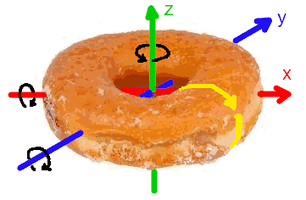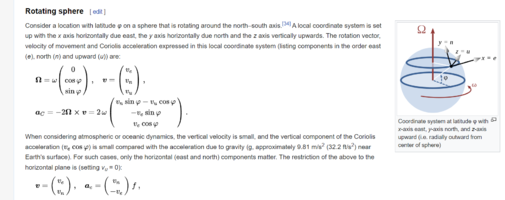Given a torus parameterization found in: https://en.wikipedia.org/wiki/Toroidal_and_poloidal_coordinates
What would the rotational matrix be?
What would the rotational matrix be?
Given a torus parameterization found in: https://en.wikipedia.org/wiki/Toroidal_and_poloidal_coordinates
What would the rotational matrix be?
So my goal is to implement the coriolis force on a torus with those coordinates (R + rcosphi)costheta and so on...). I use the reference <https://en.wikipedia.org/wiki/Coriolis_force> and in that the rotation vector used is [0, cosphi, sinphi] but that is for a sphere. So I was wondering if that would change for a torus which is why I wanted to find the rotation matrix (how the given coordinates could be rotated) would be like for a torus in those coordinates.Sorry, I don't fully understand your question. Are you asking for an explanation of how the Cartesian coordinates on that page are derived? Or, are you asking how the given coordinates could be rotated using a rotation matrix (click for example matrices) ? Or perhaps something else?
I am following the scenario of the torus rotating like Earth does, horizontally but at greater speeds.If I remember correctly the Coriolis force is caused by a rotation, so you have to decide how your torus is rotated, i.e., around each axis. Do you need to solve the general case, i.e., an arbitrary rotation axis?
A note: unlike the surface of a (ideal) sphere, most of the surface of a torus is not orthogonal to a rotation vector.

It seems that in your role as super moderator, you have adopted the stereotypical diet of a police officer on stakeoutDo you mean that there is no jelly in this donut in ANY direction? Where is the joy? That has become imaginary!!
I took a bite and there was no jelly!!
View attachment 33983
This note no longer makes sense to me, so I apologize if it caused any confusion.A note: unlike the surface of a (ideal) sphere, most of the surface of a torus is not orthogonal to a rotation vector.
I think I am starting to understand the problem: express rotation vector around Z axis (i.e. [imath](0,0,\omega)[/imath]) in local coordinates of a torus ([imath](\theta,\zeta)[/imath] in https://en.wikipedia.org/wiki/Toroidal_and_poloidal_coordinates).So my goal is to implement the coriolis force on a torus with those coordinates (R + rcosphi)costheta and so on...). I use the reference <https://en.wikipedia.org/wiki/Coriolis_force> and in that the rotation vector used is [0, cosphi, sinphi] but that is for a sphere. So I was wondering if that would change for a torus which is why I wanted to find the rotation matrix (how the given coordinates could be rotated) would be like for a torus in those coordinates.
Yes it will be rotating around the x-axis following this same explanation.Horizontal and north-south don't really gel with the x,y,z Cartesian coordinate world. A diagram would help (and I apologise for injecting some humour)...
View attachment 33980
Which of the axes does the doughnut, sorry torus, rotate around? Or, does it continually rotate "inside out" with a point on the surface following the circular path of the yellow arrow?
EDIT: By the way, the above axes and torus are in keeping with the equations given on the Wikipedia link in post#1. I guess that you require a rotation around the z axis, is this correct?

So would I still use the same rotation vector (0, costheta, sintheta)?I believe you can use the same expression as for a sphere, but replacing the longitude with the toroidal coordinate [imath]\zeta[/imath] and latitude with the poloidal [imath]\theta[/imath]. Just as in sphere the expression for the polar axis depends only on your latitude and not on your longitude, on a torus the transformation of the Z vector (0,0,1) depends only on your poloidal coordinate [imath]\theta[/imath] and is represented by [imath](0, \cos\theta, \sin\theta)[/imath].
Yes, you would. Just don't forget to multiply it by the angular speed ([imath]\omega[/imath]).So would I still use the same rotation vector (0, costheta, sintheta)?
What would the angular velocity be? Also I am a little confused on how they got the velocity and position vector in these coordinatesYes, you would. Just don't forget to multiply it by the angular speed ([imath]\omega[/imath]).
I dont quite understand why the rotation would follow the yellow arrowHorizontal and north-south don't really gel with the x,y,z Cartesian coordinate world. A diagram would help (and I apologise for injecting some humour)...
View attachment 33980
Which of the axes does the doughnut, sorry torus, rotate around? Or, does it continually rotate "inside out" with a point on the surface following the circular path of the yellow arrow?
EDIT: By the way, the above axes and torus are in keeping with the equations given on the Wikipedia link in post#1. I guess that you require a rotation around the z axis, is this correct?
My diagram was an attempt to determine exactly what type of rotation you were talking about in post#5.I dont quite understand why the rotation would follow the yellow arrow
oh i see thank you!My diagram was an attempt to determine exactly what type of rotation you were talking about in post#5.
I drew several possible rotations in such a way that you could easily respond and say "I meant a rotation around the x axis", "I meant a rotation of a point on the surface following the path of the yellow arrow", "I meant a rotation around the z axis" - or "I want a rotation that isn't shown in that diagram".
It's your question, I was trying to clarify your need. A good diagram of a situation will often make solving the problem much easier. A simple pencil sketch would be absolutely fine for our purposes (to understand what you're after)
